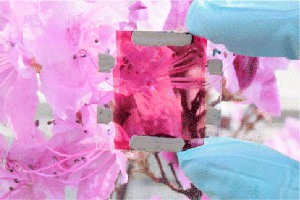
Organic solar cells (OSCs) are of interest for next-generation photovoltaic applications due to their lower costs and milder fabrication requirements relative to c-Si and thin-film devices. The power conversion efficiency (PCE) of these devices has risen to 11-12% in recent years, which is promising in order to gain market share in this competitive field. Requiring only simple spin- or dip-coating techniques, organic or polymer solar cells are an attractive low-cost technology; in recent years, there has been a focus on solution and roll-to-roll high throughput processing of OSCs to lower the fabrication costs even further.
A transparent conductive oxide (TCO) electrode that is most often used in organic solar cells is indium tin oxide (ITO). Although the optoelectronic properties and facile deposition methodologies for ITO are ideal for solar applications, it is widely recognized that the use of ITO is the key cost driver in the development of OSCs. Accordingly, there is a need to find a suitable replacement for ITO that shares its desirable properties, but is much less expensive and more amenable for plastic and flexible substrates. Not unexpectedly, carbonaceous nanostructures were the first candidates to be evaluated for such applications. Although single-walled carbon nanotubes (SWCNTs) would exhibit a suitable electrical conductivity and mechanical robustness to be used as a transparent conductive electrode, the inter-tube resistances give rise to significantly worse performance relative to ITO. Other nanostructural alternatives such as graphene have also been proposed for transparent conductive electrode applications. However, the experimental conditions used to reduce graphene oxide results in sheet resistances that are not suitable for photovoltaic applications.
The recent report by Yim et al. (ACS Nano 2014, ASAP; DOI: 10.1021/nn406672n) describes the use of silver nanowires and doped PEDOT:PSS (i.e., poly(3,4-ethylene dioxythiophene):poly(styrenesulfonate)) as the cathode and anode, respectively, within a bulk heterojunction organic solar cell employing an active layer comprised of P3HT:PCBM (i.e., poly(3-hexylthiophene-2,5-diyl):[6,6]-phenyl-C61-butyric acid methyl ester). Whereas the optoelectronic properties of silver nanowires and PEDOT:PSS are comparable to ITO, this design offers a significant improvement due to the pronounced flexibility of the Ag nanowires and plastic-substrate compatibility of the PEDOT:PSS electrode. Processing of the electrode films was accomplished by simple spin coating and annealing temperatures did not exceed 200 °C throughout the cell fabrication procedure.
Although the power conversion efficiency of this design is only 2.3%, it is comparable to the efficiency reported for analogous devices that employed an ITO electrode. Furthermore, it is likely that this could easily be improved by varying the morphologies of the Ag nanowires or incorporating other nanomaterials that could improve both visible light and IR-photon harvesting. In addition, the reported design employed a variety of buffer layers such as graphene oxide and TiOx/ZnO, which were used in order to improve adhesion between the PEDOT:PSS/active layer interface, and decrease the surface roughness of the Ag nanowire electrode, respectively. Perhaps further improvements in transparency and optoelectronic properties of the electrodes may be realized by using aligned nanowires rather than randomly organized arrays, or using other surface functionalizations that would not offset the conductive properties, but would bind more strongly to the P3HT:PCBM active layer.
References:
Fully Solution-Processed Semitransparent Organic Solar Cells with a Silver Nanowire Cathode and a Conducting Polymer Anode
Jong Hyuk Yim, Sung-yoon Joe, Christina Pang, Kyung Moon Lee, Huiseong Jeong, Ji-Yong Park, Yeong Hwan Ahn, John C. de Mello, and Soonil Lee
ACS Nano 2014 8 (3), 2857-2863 DOI: 10.1021/nn406672n
Images Reprinted (adapted) with permission from Fully Solution-Processed Semitransparent Organic Solar Cells with a Silver Nanowire Cathode and a Conducting Polymer Anode, Jong Hyuk Yim, Sung-yoon Joe, Christina Pang, Kyung Moon Lee, Huiseong Jeong, Ji-Yong Park, Yeong Hwan Ahn, John C. de Mello, and Soonil Lee; ACS Nano 2014 8 (3), 2857-2863. Copyright 2014 American Chemical Society.
